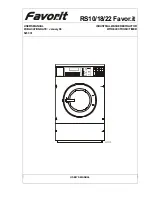
MAINTENANCE /
REP
AIR
TROUBLESHOOTING
OPERA
TION
ASSEMBL
Y /
INST
ALLA
TION
SAFETY /
SPECIFICA
TIONS
GETTING ST
AR
TED
13
Risk of property damage. Never pull water supply hose to move pres sure washer. This could
damage hose and/or pump inlet.
•
DO NOT use hot water, use cold water only.
•
Never turn water supply off while pressure washer engine is running or damage to pump will result.
•
DO NOT stop spraying water for more than two minutes at a time. Pump operates in bypass mode
when spray gun trigger is not pressed. If pump is left in bypass mode for more than two minutes
internal components of the pump can be damaged.
If you do not understand these precautions, please visit www.campbellhausfeld.com
Prior to starting, refer to your engine manual for proper starting procedure.
1. In a well ventilated outdoor area add fresh, high quality, unleaded gasoline with a pump octane
rating of 86 or higher. Do not overfill. Wipe up spilled fuel before starting the engine. Refer to Engine
Owner’s Manual for correct procedure.
IMPORTANT:
Ethanol Shield
TM
(sold separately) is a fuel stabilizer that helps eliminate and prevent ethanol
related problems in power equipment. Follow the instructions on the container and add to the gasoline.
Use of fuels with greater than 10% ethanol are not approved for
use in this product per EPA regulations and will damage the unit
and void the warranty.
2. Check engine oil level. Refer to Engine Owner’s Manual for correct procedure.
3. Check pump oil level. The oil level should come to the dot in the middle of the sight glass. Refer to the
Pump paragraph under Maintenance.
4. Connect the water hose to the water source. Turn the water source on to remove all air from the hose.
When a steady stream of water is present, turn the water source off.
5. Verify the filter screen (M) is in water inlet of pump. NOTE: Convex side faces out.
6. Connect water source (N) to pump inlet (J). NOTE: Water source must provide a minimum of 5 gallons
per minute at 20 PSI.
7. Connect high pressure hose (C) to pump outlet (I).
To reduce the possibility of contamination always protect against backflow when connected to
a potable water system.
8. Choose the correct nozzle for the job to be performed. See How To Use spray Wand instructions in this
section. NOTE: If applying a chemical or cleaning solution, see How To Apply Chemicals/Cleaning
Solvents instructions in this section.
9. Turn water source on.
Risk of property damage. Failure to do so could cause damage to the pump.
10. Remove all air from the pump and high pressure hose by depressing trigger until a steady stream of
water is present.
11. Start engine. See Engine Owner’s Manual for correct procedure.
Risk of unsafe operation. If engine does not start after two pulls, squeeze trigger of gun to
relieve pump pressure. Pull starter cord slowly until resistance is felt. Then pull cord rapidly to
avoid kickback and prevent hand or arm injury.
NOTE:
If the oil level in the engine is low, the engine will not start. If the engine does not start, check the oil
level and add oil as needed.
12. Depress trigger on gun to start water flow.
Do not allow the unit to run for more than two minutes without the gun trigger being pulled.
This could cause overheating and damage to the pump. When the temperature inside the pump
rises too high, the thermal relief valve will open and release a spray of water from the pump to lower the internal
temperature. The valve will then close.
I
C
N
J
M
Figure 22
















































